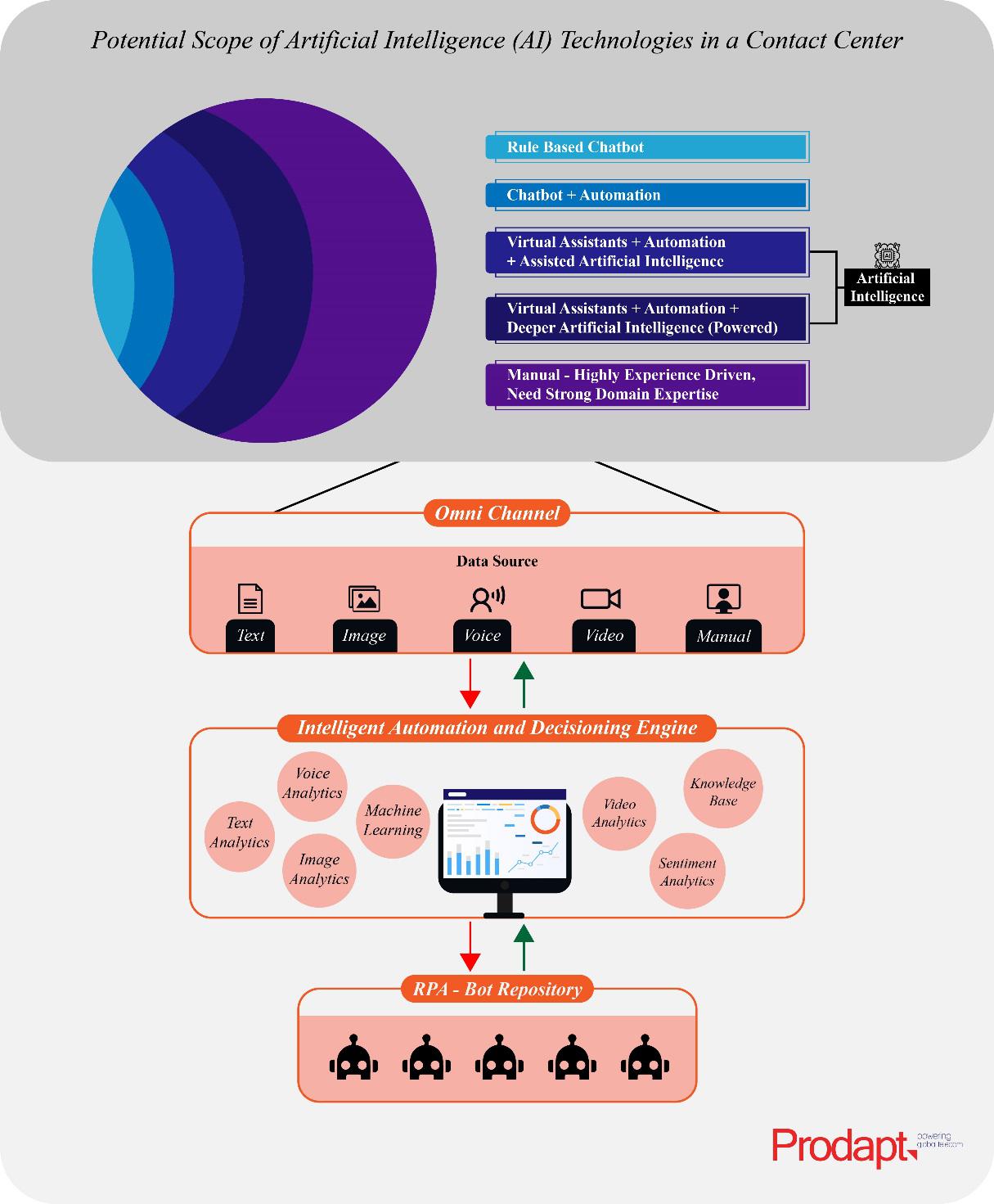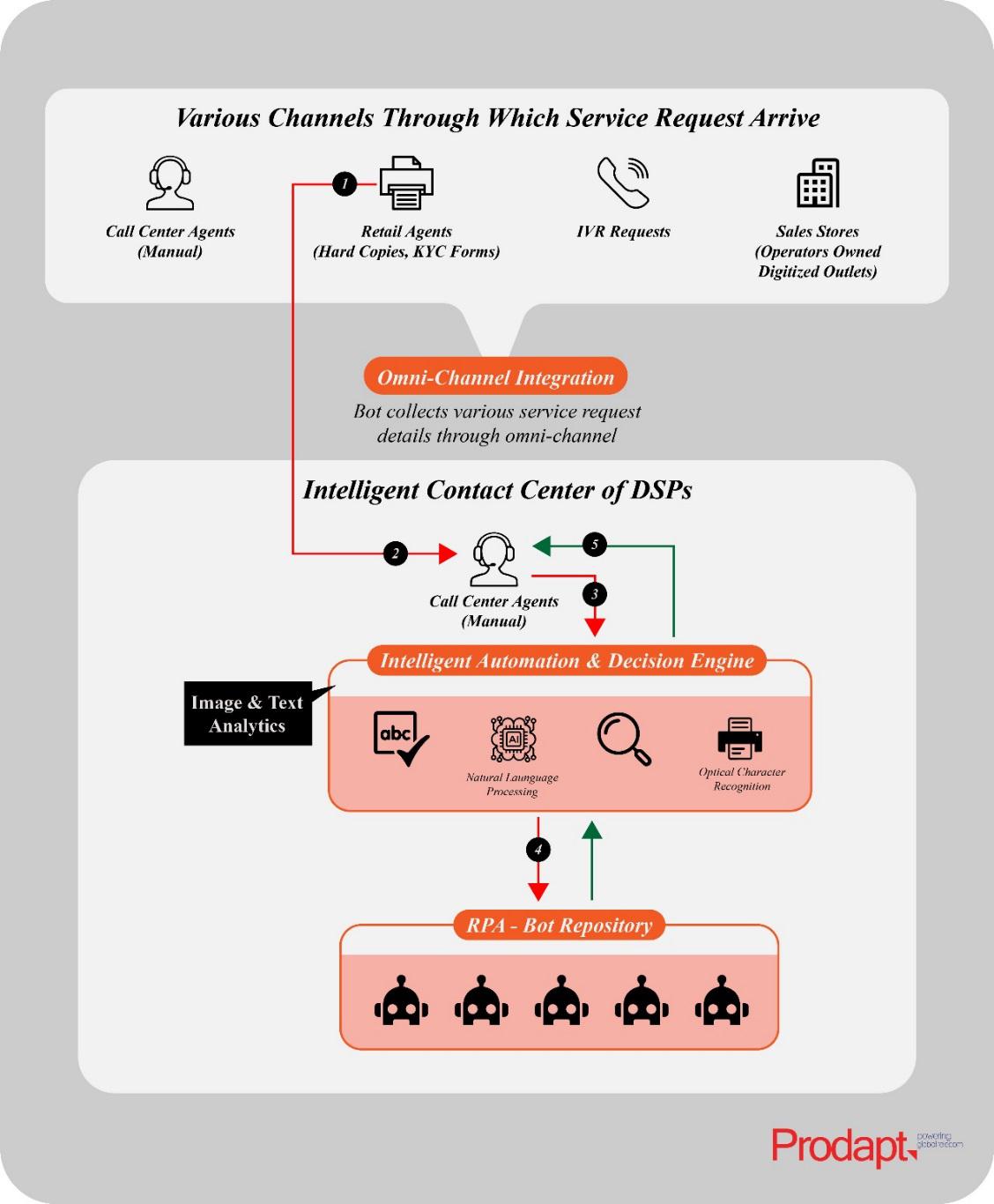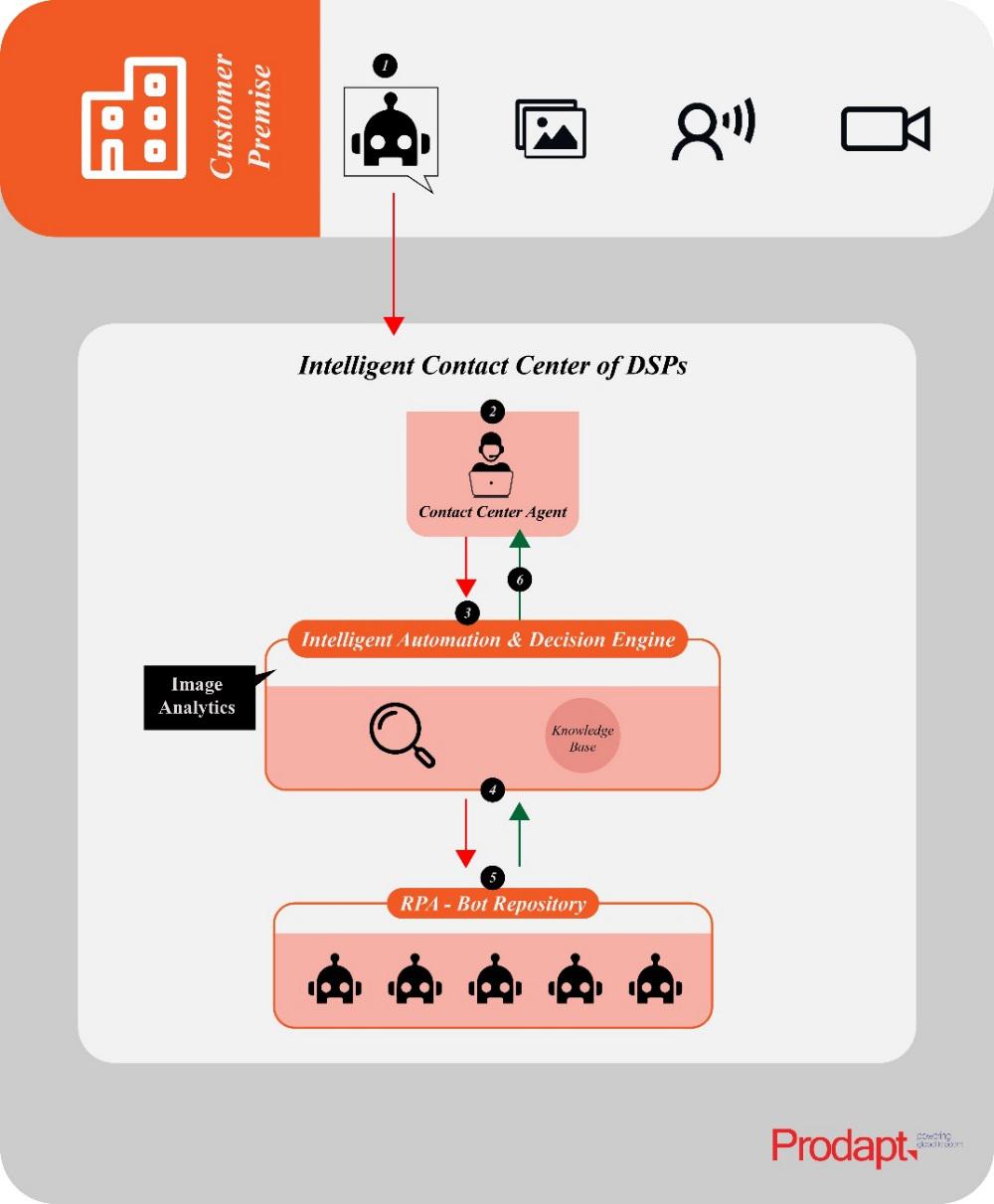Enable agents to work smarter, reduce call volume, and improve efficiency
The current state of Digital Service Providers’ (DSPs) manual or semi-automated contact centers is no more enough to provide customer delight, rapid resolution, and improved agent performance. According to Forrester, 64% of companies are planning to increase their AI investment in the contact center in the next 12 months. DSPs need to modernize their contact center landscape to a point where
- Customers can engage in the channels of their choice and have a seamless experience
- Agents are empowered with AI-assisted next-best-action recommendations and bot-assist to complete process automation
- Automation and decision engine at the core can perform text/image/voice/video analytics to enable seamless customer journey automation
This blog articulates an integrated intelligent automation approach where artificial intelligence technologies like Natural Language Processing (NLP), Machine Learning (ML), and Virtual Assistants (VA) get integrated with Robotic Process Automation (RPA). This increases the scope of automation in customer engagement journeys and further drives improvement in efficiency and handling time of contact centers.
The Need for Inclusion of NextGen Technologies
In the current scenario of technological evolution and digitization, consumers have loads of channels available at their disposal to contact their DSP. This puts DSPs’ contact centers in a challenging spot because customers not only expect them to be available at every such channel but also remain responsive and proactive on all of them. Omnichannel presence is no more just a ‘good to have’ feature but a necessity in serving the end consumers. The major challenges, other than omnichannel integration, affecting contact centers are:
- Not enough staff to handle the workload
- Lack of self-service or bad self-service
- Poor cross-departmental collaboration
- Increasing handling time
- Lack of know-how among support resources
Digitization and automation are the two major tools that contact centers need to adopt and sharpen further to address these issues.
Building Systems Capable of Processing all Data Types – The Key to Develop a True Omni-channel Experience
The increasing customer expectations are calling for a paradigm shift from customer service management to customer experience management. Contact centers are looking to build a digital workforce in lieu of their automation strategy by integrating elements of RPA, AI, NLP, ML, and analytics to automate their business processes. Developments are being made to automate processes that were earlier deemed non-automatable owing to their input in unstructured formats like free flow text documents and scanned images. Therefore, these newer technologies are developed to assist and help the agents in their interaction with customers and drive more satisfaction. The following focus areas align with the vision of most contact centers:
- AI should complement live agents
- Self-service should be available for transactional issues and live agents to be available for complex issues
- All contact touchpoints and engagement functions should be aligned
- Quality scorecard should measure customer satisfaction
It is no surprise that to achieve this vision, the major priority for contact centers is improving offerings in digital channels and using AI in customer engagement to improve efficiency and customer satisfaction scores.
With the next generation of intelligent process automation becoming a strategic differentiator, organizations must develop the capability to process all categories of structured and unstructured data inputs to deliver an omnichannel experience and align all their channels. These categories include – text, image, voice, video, and manual inputs. The current rule-based chatbots and virtual agents (VAs) backed by NLP can process structured and limited cases of semi-structured data. The next stage is where AI technologies like ML, deep learning, computer vision algorithms, and optical character recognition (OCR) can understand the inputs in unstructured voice and video formats as well as aid the agents in decision making. These technologies can integrate with RPA bots and trigger required actions based on unstructured customer input as illustrated in Figure-1.

Figure-1: AI integration with RPA bots to assist agents in the next best action
A central decision engine is key to this implementation. It will take in data from any channel, understand the intent behind them, and trigger the bot for the next best action based on text/image/speech/voice/video analytics. Image analytics will help in building and serving scenarios where customers are uploading images of their faulty products or scanned images of hard copies. This solution, further aided by voice and video analytics will provide an all-encompassing response to communication from any channels, thus ensuring the DSP provides a true AI-powered omnichannel experience to their customers. Now, let us see two interesting use cases to illustrate how DSPs’ AI-assisted contact centers can drive huge business benefits.
AI-assisted Contact Center Use Case 1: Handling Non-digital Service Requests

1. The customer interacts with retail agents and submits their service request forms and KYC forms as hard copies for validation. The retail agent scans all the service request forms related to a specific customer and uploads it into the customer care portal.
2. The contact center agent receives scanned images of customer service request forms for further processing and KYC forms for validating customer authenticity.
3. OCR module present in the intelligent automation and decision engine performs image analytics and converts the image format to unstructured text format.
4. NLP module performs text analytics and various preprocessing techniques and applies classification methods to interpret the unstructured data.
5. The decision engine recommends the next best action to the RPA bots. For example, to process a new connection installation – service request for provisioning.
6. RPA bot completes the remaining steps in the service provisioning request and makes the service available to the customer. A response notification is sent to the contact center agent.
AI-assisted Contact Center Use Case 2: Enabling Tech Support Agents with Automated Resolution

1. Image upload: The customer takes the image of the faulty modem using mobile and uploads it via the self-service app for further investigation.
2. Agent assignment: The agent picks up the incident/trouble ticket at the contact center and initiates intelligent automation and decision engine to perform analysis.
3. Image analytics: Intelligent automation and decision engine perform image analytics to identify device type, manufacturer details, and verifies the knowledge database with error code to identify any similar past occurrences.
4. Decision: Once the root cause of the issue is identified, the decision engine recommends the next best actions with all possible options. The agent chooses the right recommendation from the list of options available.
5. Triggering RPA bot: Corresponding RPA bot gets triggered from the repository to perform configuration change and reboot actions appropriately.
6. Resolution: Once the issue gets resolved after rebooting the modem, it pops up in the agent terminal to notify the customer.
In Conclusion…
By leveraging intelligent process automation as elaborated in this article, DSPs can experience
- Increase in customer satisfaction scores
- Improved first call resolution rates
- Reduction in contact center call volume, average call handling time & customer service processing time
By Rajesh Khanna

Director – Delivery Lean/Consultant
Rajesh Khanna has 20+ years of experience in the IT/ITES/Telecom Industry leads RPA Delivery & Process Consulting team in Chennai, India focusing on Automation and Transformation projects across different accounts. He is instrumental in streamlining and optimizing operations by implementing Robotic Process Automation (RPA).
Rajesh is a certified Lean practitioner and ISO auditor. He has led process improvement initiatives through lean six sigma methodologies, automation, and kaizen. Executed multiple consulting projects aiming at eliminating waste, improving accuracy, cost-benefit, cycle time reduction, productivity improvement directly impacting the bottom line.


